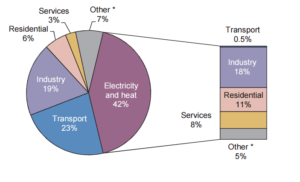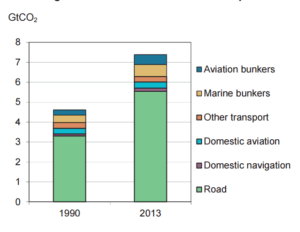DHL decides to Go Green and set targets for own carbon emissions!

The climate change is undeniable, and approximately 85% of all Carbon emissions are concentrated in 3 sectors. Companies in those sectors should be the ones most concerned about reduction initiatives, not only because of current and potentially new regulation policies, but also because of customers preferences and perceptions on companies that are not concerned with environmental protection initiatives. Nielsen has released a research that states that 45% of consumers are willing to pay more for an environmentally friendly product, proving that this issue is important to consumers.
According to the CO2 Emissions from Fuel Combustion report released by the International Energy Agency (IAE) in 2015, transport is responsible for 23% of global energy-related greenhouse gas emissions
World CO2 emissions by sector
Among these transports, “road” is not only the biggest one, but also the one responsible for most of the CO2 emissions increase since 1990.
CO2 emissions from transport
The DHL Program
DHL is the world’s leading mail and logistics group and, in 2008, pushed by stricter emission standards expected by regulators and consumers, decided to start focusing its efforts on climate protection, mainly through the reduction of carbon dioxide (CO2) emissions.
DHL was the first logistics company to set a clear carbon emission target and kickoff a sustainability program in 2008: the “Go Green” program has a target to reduce in 30% the Carbon emission levels by 2020 (based on 2007 levels) and increase transparency on company ‘s carbon emission levels.
This was a breakthrough move in an industry that has a business model that relies heavily on carbon emissions to survive. The carbon reduction strategy proposed focused on the three main initiatives below (but was not limited to):
- Network optimization – ensuring the shortest and most efficient routes to reduce the amount of fuel required in deliveries
- Fleets modernization
- Cars – shift towards alternative cars (electric, hybrid) and improve aerodynamics reduce the CO2 emissions
- Aircraft – renewal of fleets to more consumption efficient models
- Increase energy efficiency of buildings – reducing consumption and increasing usage of renewable sources (e.g. solar energy)
Results so far
As of 2015, DHL had already managed to reach approximately 25% out of the 30% reduction target set internally.
Source: investors relations website
Suggestions for future reductions
DHL has definitely taken a big step ahead just by implementing these reduction policies, but there is still room for further improvement. Going forward, I suggest that DHL start working on the three initiatives listed below:
- Further improving its fleet
- Expand alternative fleets – while electric cars would be the best solution, they are still expensive and somewhat scarce. However, it would be possible to reduce emissions now by changing the fleet to ethanol-moved cars, a technology that is cheap, available and wide-spread in some countries, such as Brazil
- Use lighter cars / aircraft to reduce fuel consumption– negotiate with suppliers to produce cars and aircraft with lighter materials and / or less accessories. In theory, DHL could even negotiate lower prices if the only change is in number of accessories, not to mention reduction in fuel consumption
- Educate consumers on the cost that short-term deliveries have to the environment and stimulate them to select green options, even if they are more expensive (have the traditional and green option available for everyone)
- Have indirect impact through waste reduction (reducing impact of the “industry” sector) by re-utilizing packages and stimulating consumers to do the same (maybe even offer a small monetary incentive)
Implementing these carbon reduction initiatives have the potential not only to impact the environment, but also to improve DHL’s results through cost reduction and top line growth through the creation of a brand that cares about the environment and wants to leave a legacy to the industry.
(619 words)






The transportation industry has been slow to adapt, but is making considerable changes in how they transport goods in order to cut costs and reduce emissions. One of the main reasons is the investment in infrastructure such as cars and airplanes is significant and these investments are expected to be in use for years. With aircraft in particular, the newer aircraft have more carbon fiber and honeycomb parts than older generation aircraft, however airplanes are used in the industry can have long lifespans of over 25 years [1] if they are on longer distance flights. By waiting until the next generation of aircraft are being produced, the newest models have carbon fiber frames and are seeing far more fuel savings than previous hybrid models [2]. There are not many accessories that can be left off long-haul carriers as they are generally as empty as possible to accommodate extra weight and sizes of packages. Other efficiencies that are less capital intensive than purchasing all-new aircraft could be retrofitting legacy aircraft with winglets to decrease drag off the wing [3], or decreasing the amount of fuel on board at take off by doing better winds-aloft calculations. Each extra pound of weight at takeoff is extra fuel needed to take it off, and the majority of the weight on a cargo carrier is the fuel itself. So by figuring out the exact needs for fuel consumption, excess fuel to divert, 30 minutes of emergency fuel, airlines could see significant fuel and cost savings by cutting down on the weight of fuel at take off to closer to what they will be needing. This is already done by the airline industry and military aviation, however some cargo carriers still have higher allowances for fuel in the name of standardization so that it is easier to fuel a fleet of aircraft to the same level, instead of fueling them just-in-time based off the weather conditions at the time of flight. Additional efficiencies can be found with flight planning at optimum altitudes and airspeeds that may not be as quick to reach the destination, but are at a reduced speed that is more efficient for the engines.
[1] Air&Space Magazine, “What Determines an Airplanes Lifespan,” http://www.airspacemag.com/need-to-know/what-determines-an-airplanes-lifespan-29533465/?no-ist, accessed November 6, 2016.
[2] University of Pittsburgh, “Carbon Fiber Aircraft Frames and Their Effect on the Aviation Industry,” http://www.pitt.edu/~ntv5/engineeringtrends.html, accessed November 6, 2016
[3] NASA Spinoff, “Winglets Save Billions of Dollars in Fuel Costs,” https://spinoff.nasa.gov/Spinoff2010/t_5.html, accessed November 6, 2016.
Really interesting post on DHL’s effort to reduce its carbon footprint. What I found particularly attractive about the company is that DHL is optimizing for its own sustainability improvements while simultaneously working to help its customers monitor and reduce carbon emissions in their respective supply chain management practices. This is quite mutually beneficial. This B2B service offering should help DHL bolster its competitive position as firms become increasingly focused on energy efficiency in business operations. In many cases, monitoring the extent to which a company is operating carbon efficiently can also help the organization think about cost structure optimization opportunities. DHL’s Green Logistics unit provides several case studies of businesses which were able to reduce emissions while concurrently bolstering their bottom line. [1] Perhaps the company could use this service offering as a competitive advantage to win more business going forward.
[1] DHL. DHL Green Logistics Solutions. http://www.dhl.com/en/logistics/green_logistics_solutions.html#case_studies
Interesting article, YM! I really like your suggestions on future reduction, especially item 2 on educating consumers about the positive environment impact of choosing green options. As DHL continues to invest in its operations and fleets to lower carbon footprint, the company will inevitably face another challenge: higher investment requirements and rising costs, which will likely translate into higher prices to end-consumers. It is critical that DHL communicate its “Go Green” effort clearly to consumers in order to gain support and justify higher prices charged to consumers for the same level of services. Otherwise, “Go Green” can result in a negative financial performance of the company despite its positive contribution to the environment.
Great article! Thanks for laying out the problem and DHL’s solution so succinctly. It appears that DHL is doing a far bit to implement a green supply chain. However, as we move more and more towards an “on-demand” economy, I question the premise that DHL will be able to impact consumer decision-making and reduce short-term deliveries, even if these are better for the environment. I wonder if consolidation or collaboration within the industry (especially for the “last-mile” delivery) may be a potential solution to increase efficiencies here and minimize the carbon impact as demand continues to grow. What do you think?
This month, DHL announced that it has extended its GoGreen initiative and set a more aggressive long term target: zero emissions by 2050 [1] As a milepost, whereas their previous target was a 30% reduction in emissions by 2020 over their 2007 level (which they achieved in 2016), their new target is now a 50% reduction over that 2007 level by 2025.
[1] Group-wide environmental protection program GoGreen defines new global target: zero emissions by 2050 http://www.dpdhl.com/en/responsibility/environmental-protection.html